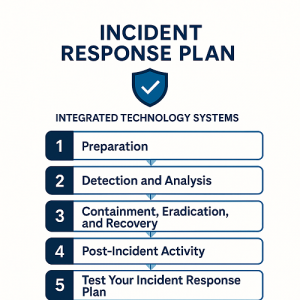A Complete Guide for Today’s Threat Landscape
 In today’s cybersecurity climate, even the strongest defenses can be bypassed. Whether through direct compromise or a supply-chain vulnerability, organizations of all sizes face a high likelihood of a cybersecurity incident.
In today’s cybersecurity climate, even the strongest defenses can be bypassed. Whether through direct compromise or a supply-chain vulnerability, organizations of all sizes face a high likelihood of a cybersecurity incident.
A well-built incident response plan is your best defense. It minimizes downtime, reduces financial and operational impacts, ensures regulatory compliance, and helps preserve trust with customers and employees.
At Integrated Technology Systems, we help businesses strengthen cyber resilience with
- advanced monitoring
- actionable intelligence
- ongoing security improvements.
Below is a step-by-step guide to building an effective incident response plan that prepares your organization for whatever comes next.
What Is an Incident Response Plan?
An incident response plan (IRP) is a structured, actionable guide that outlines how your organization prepares for, identifies, contains, and recovers from a cyberattack.
A strong IRP helps your business:
- Contain threats quickly
- Reduce operational disruption
- Limit data loss and financial damage
- Meet regulatory and reporting requirements
- Improve long-term cybersecurity posture
- Maintain trust with stakeholders
It is also a key element of your broader risk-management strategy and a roadmap for making smarter cybersecurity investments.
What an Incident Response Plan Should Include
A comprehensive incident response plan typically contains:
- An overview of the importance of incident response
- A defined framework, often based on the NIST four-stage model:
- Preparation
- Detection and analysis
- Containment, eradication, and recovery
- Post-incident activity
5 Steps to Creating an Effective Incident Response Plan
 Multiple resources—provided by Integrated Technology Systems —offer best practices for incident response planning. Regardless of the framework, your plan should always include these five essential steps.
Multiple resources—provided by Integrated Technology Systems —offer best practices for incident response planning. Regardless of the framework, your plan should always include these five essential steps.
Step 1: Preparation
Preparation lays the groundwork for every other stage of the incident response process.
Key actions include:
- Establish a clear incident response policy and escalation procedure
- Identify your incident response leader—often a CISO, security manager, or trusted third party
- Build a multidisciplinary incident response team (IT, legal, HR, communications, management)
- Define roles, expectations, communication channels, and decision-making authority
- Train your team regularly and update documentation frequently
A simple, executive-friendly plan will gain more buy-in and ensure smoother response during an actual incident.
Step 2: Detection and Analysis
This phase focuses on identifying potential breaches and determining their scope.
Key tools and processes:
- Attack surface analytics
- Continuous monitoring
- Endpoint protection and EDR
- Firewalls and intrusion detection systems
- SIEM solutions for real-time event correlation
Early detection reduces the severity of damage. With Integrated Technology Systems’ advanced monitoring capabilities, organizations gain immediate visibility into suspicious activity and emerging threats.
Step 3: Containment, Eradication, and Recovery
Once an incident is identified, your priority is to contain the threat and prevent further impact.
Critical steps include:
- Isolate affected systems
- Identify the root cause and remove malicious elements
- Patch vulnerabilities and restore systems
- Score and classify incidents based on severity and business impact
- Document all actions taken and evidence collected
This documentation is essential not only for legal and regulatory reasons, but also for improving future response efforts.
Step 4: Post-Incident Activity
After the incident, hold a formal review to ensure your team learns from the event.
Discuss and document:
- Full incident timeline
- Mean Time to Detect (MTTD) and Mean Time to Repair (MTTR)
- Systems, data, customers, and business processes affected
- Effectiveness of containment and remediation steps
- Improvements needed
If your organization is regulated—such as under the SEC cybersecurity disclosure requirements—ensure compliance with reporting timelines.
Step 5: Test Your Incident Response Plan
A plan is only effective if it works during real conditions.
Recommended exercises:
- Ransomware simulations
- Insider threat scenarios
- Phishing or credential compromise drills
- Supply chain attack simulations
Routine testing strengthens your organization’s cyber readiness and reveals gaps before attackers do.
Build Stronger Cyber Resilience with Integrated Technology Systems
As modern attack surfaces expand across on-premise environments, cloud platforms, and distributed teams, maintaining strong cyber resilience requires more than traditional tools.
Integrated Technology Systems empowers your organization to:
- Identify vulnerabilities before attackers exploit them
- Gain continuous visibility into emerging threats
- Pinpoint the root cause of incidents with actionable intelligence
- Implement targeted remediation plans
- Measure and demonstrate security improvements over time
Whether you're building your first incident response plan or optimizing an existing one, we help you strengthen your defenses and minimize risk.
Frequently Asked Questions (FAQ)
1. Why is an incident response plan important?
It reduces the impact of cyberattacks, speeds up recovery, helps organizations meet regulatory requirements, and strengthens overall cybersecurity posture.
2. How often should we update our incident response plan?
Update your plan at least annually—or whenever major organizational changes, new technologies, or significant threats arise.
3. Who should be on an incident response team?
Typically: IT/security leads, executive leadership, legal, HR, communications, and sometimes third-party cybersecurity partners.
4. What tools help support incident response?
Monitoring tools, SIEM, EDR, vulnerability management platforms, backup systems, and threat intelligence solutions.
5. How do we know if our incident response plan is effective?
Regular testing, measurable KPIs (MTTD, MTTR), and consistent improvement after simulated or real incidents help you determine effectiveness.
Ready to Strengthen Your Incident Response Plan?
Integrated Technology Systems helps organizations prepare for, respond to, and recover from cyber threats with confidence. Contact us today to schedule a consultation and build a stronger, more resilient cybersecurity strategy.
Integrated Technology Systems
6 East 45th Street, Suite 400
New York, NY 10017
212-750-5420
https://www.itsnyc.com



